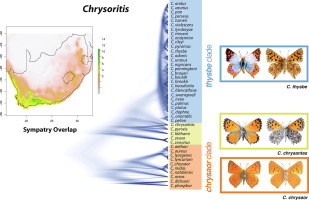当前位置:
X-MOL 学术
›
Mol. Phylogenet. Evol.
›
论文详情
Our official English website, www.x-mol.net, welcomes your feedback! (Note: you will need to create a separate account there.)
Recent diversification of Chrysoritis butterflies in the South African Cape (Lepidoptera: Lycaenidae).
Molecular Phylogenetics and Evolution ( IF 4.1 ) Pub Date : 2020-04-11 , DOI: 10.1016/j.ympev.2020.106817 Gerard Talavera 1 , Zofia A Kaliszewska 2 , Alan Heath 3 , Naomi E Pierce 4
Molecular Phylogenetics and Evolution ( IF 4.1 ) Pub Date : 2020-04-11 , DOI: 10.1016/j.ympev.2020.106817 Gerard Talavera 1 , Zofia A Kaliszewska 2 , Alan Heath 3 , Naomi E Pierce 4
Affiliation

|
Although best known for its extraordinary radiations of endemic plant species, the South African fynbos is home to a great diversity of phytophagous insects, including butterflies in the genus Chrysoritis (Lepidoptera: Lycaenidae). These butterflies are remarkably uniform morphologically; nevertheless, they comprise 43 currently accepted species and 68 currently valid taxonomic names. While many species have highly restricted, dot-like distributions, others are widespread. Here, we investigate the phylogenetic and biogeographic history underlying their diversification by analyzing molecular markers from 406 representatives of all described species throughout their respective ranges. We recover monophyletic clades for both C. chrysaor and C. thysbe species-groups, and identify a set of lineages that fall between them. The estimated age of divergence for the genus is 32 Mya, and we document significantly rapid diversification of the thysbe species-group in the Pleistocene (~2 Mya). Using ancestral geographic range reconstruction, we show that West Fynbos is the most likely region of origin for the radiation of the thysbe species-group. The colonization of this region occurred 9 Mya and appears to have been followed by a long period of relative stasis before a recent increase in diversification. Thus, the thysbe radiation does not appear to have resulted from the colonization of new biogeographic areas. Rather, the impact of species interactions (with ants and plants), the appearance of key innovations, and/or the opening of new ecological niche space in the region might explain the sudden burst of speciation that occurred in this group 2 Mya. The biogeographic model suggests two different diversification processes with few historical cross-colonisations, one in eastern South Africa for the C. chrysaor group and the other in western South Africa for the remaining taxa. Distributional range assessments and ecological niche models for each species show important niche overlap, and in a few cases, complete overlap. However, these shared traits are not explained by phylogenetic history. Chrysoritis taxa frequently fly in sympatry and gene tree reticulation appears to be widespread at the species level, suggesting that several episodes of range shifts might have led to secondary sympatries, allowing limited gene flow that challenges species delimitation efforts. In addition, the unusually high diversification rate for the thysbe clade of 1.35 [0.91-1.81] lineages per million years also suggests the possibility of taxonomic oversplitting. The phylogeny presented here provides a framework for a taxonomic revision of the genus. We highlight cases of potential synonymy both in allopatry and sympatry, and stress the importance of dedicated studies to assess potential pre- and post-zygotic barriers giving rise to species delimitations of the thysbe group.
中文翻译:

南非海角的蝶类蝴蝶最近的多样化(鳞翅目:Lycaenidae)。
尽管以其特有的植物特有的辐射而闻名,但南非的雌雄同体却是多种植物性食虫昆虫的家园,其中包括蝶ry属的蝴蝶(鳞翅目:Lycaenidae)。这些蝴蝶在形态上非常均匀。但是,它们包含43个当前被接受的物种和68个当前有效的分类名称。尽管许多物种的点状分布受到严格限制,但其他物种却分布广泛。在这里,我们通过分析来自所有描述物种的406个代表的分子标记(在整个范围内)来研究其多样化的系统发生史和生物地理历史。我们为C. chrysaor和C. thysbe物种组恢复单系进化枝,并确定一组落入它们之间的世系。该属的估计发散年龄为32 Mya,我们记录了更新世(〜2 Mya)中的thysbe物种组明显快速的多样化。使用祖先的地理范围重建,我们表明西菲博斯岛是最可能的thysbe物种群辐射的起源地区。该区域的定殖发生在9 Mya,似乎在长期的相对停滞之后,最近才开始多样化。因此,thysbe辐射似乎不是由新的生物地理区域的殖民化引起的。而是,物种相互作用(与蚂蚁和植物)的相互作用,关键创新的出现和/或该地区新生态位空间的开放可能解释了在这2组Mya中发生的物种突然爆发。生物地理模型提出了两种不同的多样化过程,几乎没有历史性的跨殖民化过程,一个在南非东部的C. chrysaor组,另一个在南非西部的其余类群。每个物种的分布范围评估和生态位模型显示出重要的位点重叠,在某些情况下,完全重叠。但是,系统发育史并不能解释这些共有的特征。金龟属类群经常在交配中飞翔,基因树的网状结构似乎在物种水平上很普遍,这表明范围转移的几次发作可能导致次生同伴,从而限制了基因流动,从而挑战了物种划定工作。此外,thysbe进化枝的变异率异常高,为1.35 [0.91-1。[81]每百万年的血统也表明生物分类过度分裂的可能性。这里介绍的系统发育为该属的分类学修订提供了框架。我们着重介绍了异位术和共生术中潜在同义的案例,并强调了专门研究的重要性,以评估可能引起thysbe组物种界定的合子前后障碍。
更新日期:2020-04-13
中文翻译:

南非海角的蝶类蝴蝶最近的多样化(鳞翅目:Lycaenidae)。
尽管以其特有的植物特有的辐射而闻名,但南非的雌雄同体却是多种植物性食虫昆虫的家园,其中包括蝶ry属的蝴蝶(鳞翅目:Lycaenidae)。这些蝴蝶在形态上非常均匀。但是,它们包含43个当前被接受的物种和68个当前有效的分类名称。尽管许多物种的点状分布受到严格限制,但其他物种却分布广泛。在这里,我们通过分析来自所有描述物种的406个代表的分子标记(在整个范围内)来研究其多样化的系统发生史和生物地理历史。我们为C. chrysaor和C. thysbe物种组恢复单系进化枝,并确定一组落入它们之间的世系。该属的估计发散年龄为32 Mya,我们记录了更新世(〜2 Mya)中的thysbe物种组明显快速的多样化。使用祖先的地理范围重建,我们表明西菲博斯岛是最可能的thysbe物种群辐射的起源地区。该区域的定殖发生在9 Mya,似乎在长期的相对停滞之后,最近才开始多样化。因此,thysbe辐射似乎不是由新的生物地理区域的殖民化引起的。而是,物种相互作用(与蚂蚁和植物)的相互作用,关键创新的出现和/或该地区新生态位空间的开放可能解释了在这2组Mya中发生的物种突然爆发。生物地理模型提出了两种不同的多样化过程,几乎没有历史性的跨殖民化过程,一个在南非东部的C. chrysaor组,另一个在南非西部的其余类群。每个物种的分布范围评估和生态位模型显示出重要的位点重叠,在某些情况下,完全重叠。但是,系统发育史并不能解释这些共有的特征。金龟属类群经常在交配中飞翔,基因树的网状结构似乎在物种水平上很普遍,这表明范围转移的几次发作可能导致次生同伴,从而限制了基因流动,从而挑战了物种划定工作。此外,thysbe进化枝的变异率异常高,为1.35 [0.91-1。[81]每百万年的血统也表明生物分类过度分裂的可能性。这里介绍的系统发育为该属的分类学修订提供了框架。我们着重介绍了异位术和共生术中潜在同义的案例,并强调了专门研究的重要性,以评估可能引起thysbe组物种界定的合子前后障碍。



























 京公网安备 11010802027423号
京公网安备 11010802027423号